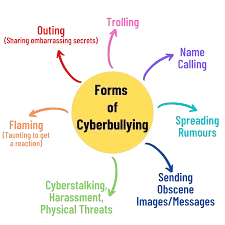 Introduction to Cyber Harassment
Introduction to Cyber Harassment
Are you constantly receiving threatening messages online? Do you feel like someone is always watching your every move in the digital world? Cyber harassment is a serious issue that many individuals face daily.
In this blog post, we will delve into what cyber harassment entails, its various forms, and most importantly, how you can protect yourself against it.
Let’s dive in and arm ourselves with the knowledge to combat this pervasive threat lurking behind screens.
Types of Cyber Harassment

Cyber harassment comes in various forms, each posing a threat to individuals online.
One common type is cyberbullying, where someone uses digital platforms to intimidate or harm others. This can include spreading rumors, sharing embarrassing photos or videos, or sending threatening messages.
Another form of cyber harassment is doxxing, where personal information such as addresses, phone numbers, and social security numbers are publicly shared without consent. This invasion of privacy can lead to real-life dangers for the victim.
Doxxing, a troubling issue affecting an estimated 43 million Americans, often involves the disclosure of victims’ residence addresses in 90% of cases. Statistics reveal that 13% of males and 21% of women have personally experienced its impact.
A significant 52% of doxxing incidents stem directly from online encounters with unknown individuals. Legally, the UK considers doxxing a criminal act. A 2019 survey found that over 10% of secondary school pupils engaged in doxxing activities. Doxxing remains illegal in Australia and Germany.
Online stalking is also prevalent in cyber-harassment cases. Stalkers may constantly monitor their victims’ online activities, send excessive messages, or even create fake profiles to track their every move. This behavior can be extremely distressing and cause significant emotional harm.
Furthermore, impersonation or identity theft online can have serious consequences for the victim’s reputation and personal relationships. Hackers may assume someone else’s identity to damage their credibility or commit fraudulent acts under their name.
It’s essential to recognize these different types of cyber harassment so that individuals can take steps to protect themselves and seek help when needed.
The Impact of Cyber Harassment
Cyber harassment can have devastating effects on its victims, both mentally and emotionally. The constant barrage of hurtful messages or threats can lead to feelings of anxiety, depression, and even post-traumatic stress disorder. Victims may experience a loss of self-esteem and confidence as they struggle to cope with the relentless online abuse.
The impact of cyber harassment extends beyond just the individual being targeted. It can also affect their relationships with friends and family, causing strain and isolation. In severe cases, victims may even fear for their physical safety due to the threatening nature of the harassment they are facing.
Moreover, cyber harassment can have long-lasting consequences on one’s professional life. Negative online content or false accusations spread by harassers can damage a person’s reputation and career prospects. The psychological toll combined with potential real-world repercussions makes it crucial to address cyber harassment promptly and effectively.
Steps to Protect Against Cyber Harassment
In the digital age, protecting yourself against cyber harassment is crucial. Here are some steps you can take to safeguard your online presence:
Ensure your privacy settings on social media platforms are set to maximum security. Limit the amount of personal information visible to strangers.
Be cautious about who you interact with online. Avoid engaging with individuals who exhibit suspicious or harassing behavior.
Regularly update your passwords and use strong, unique ones for different accounts. This adds an extra layer of protection against hackers and cyberbullies.
Use online protection tools like VPN. The best way to describe a VPN is to look at it as a way of establishing a protected network through which all your traffic passes while you’re browsing the internet on a public network. Make sure to opt for a reputable VPN provider.
Additionally, educate yourself on the signs of cyber harassment so you can identify it early and take action promptly.
Moreover, consider using reputable cybersecurity software and tools to protect your devices from malware and unauthorized access.
By implementing these proactive measures, you can reduce the risk of falling victim to cyber harassment and enhance your online safety.
Best VPN for Online Safety
HideIPVPN offers a VPN service with military-grade encryption, and high-speed servers with unlimited bandwidth.
Our service comes with shared IP addresses so that your activity can never be tied to one particular user, further protecting your privacy.

We also offer DNS leak protection, a Kill Switch, the latest VPN protocols, and a guaranteed no-log policy.
Best VPN Deal! Get HideIPVPN for $2.7/mo!
Every purchase you make comes with a 30-day money-back guarantee.
Legal Actions Against Cyber Harassment

Legal actions against cyber harassment can vary depending on the severity of the situation. Victims have the option to seek legal recourse through civil or criminal channels. Civil actions may involve filing a lawsuit against the harasser for damages, while criminal charges could be pursued if the harassment involves threats or explicit content.
In many jurisdictions, laws specifically address cyber harassment and online abuse. These laws aim to protect individuals from malicious online behavior and hold perpetrators accountable for their actions. It’s essential for victims to document all instances of cyber harassment as evidence in potential legal proceedings.
Working with law enforcement and legal professionals knowledgeable in cyber laws can help victims navigate the complex process of seeking justice. Legal remedies such as restraining orders or cease-and-desist letters may also be available to stop further harassment.
By understanding their rights and options under the law, victims of cyber harassment can take steps to protect themselves and hold perpetrators responsible for their harmful behavior.
Support and Resources for Victims
Support and resources for victims of cyber harassment are essential in helping them navigate through the emotional turmoil and practical challenges they may face. Organizations like Cyber Civil Rights Initiative offer guidance on legal options, technological solutions, and emotional support to individuals experiencing online abuse.
Victims can also reach out to hotlines such as the National Domestic Violence Hotline or RAINN for immediate assistance and advice. These helplines provide a safe space for victims to share their experiences confidentially and receive personalized help tailored to their needs.
Online platforms like HeartMob or Crash Override Network connect victims with trained advocates who can provide support, resources, and strategies for dealing with cyber harassment effectively. Additionally, therapy services specializing in trauma recovery can aid victims in processing their experiences and developing coping mechanisms.
It’s crucial for victims to know that they are not alone in this battle against cyber harassment. Seeking support from these organizations can empower individuals to take back control of their online presence and work towards healing from the harm caused by digital abuse.
Conclusion
In a world where the digital landscape continues to evolve, cyber harassment has unfortunately become more prevalent. It is crucial for individuals to understand what cyber harassment entails and how they can protect themselves against it.
By being aware of the different types of cyber harassment, such as online bullying, doxxing, and stalking, individuals can recognize when they are being targeted and take steps to address the issue. The impact of cyber harassment can be severe, leading to emotional distress, anxiety, and even physical harm in some cases.
To protect against cyber harassment, individuals should practice good online hygiene by securing their personal information and being cautious about who they interact with online. Additionally, seeking support from friends, family, or mental health professionals can help victims cope with the trauma caused by cyber harassment.
Legal actions against cyber harassers are available in many jurisdictions to hold perpetrators accountable for their actions. By reporting incidents of cyber harassment to law enforcement or relevant authorities, victims can seek justice and prevent further harm.
Support and resources for victims of cyber harassment are also widely available through organizations such as helplines and advocacy groups. These resources offer guidance on how to navigate through the challenges of dealing with cyber harassment while providing emotional support along the way.


